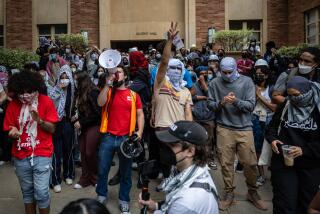Soviet Armenians Practice What They Preach: Liberty
- Share via
YEREVAN, Soviet Armenia — The people of Yerevan have become Armenia’s congress-in-the-square.
Since Moscow’s rejection last summer of their bid to reunite the Nagorno-Karabakh region with this smallest of the Soviet republics, as many as half a million people daily have been meeting in Opera (now Liberty) Square to press greater civil, cultural and environmental demands. They show their extended fists when they agree with the decisions of their organizers; they whistle to escort an unwanted speaker off stage; they welcome supporters from Estonia, Lithuania, Russia, the Ukraine and other parts of the Soviet Union; they submit thousands of written criticisms, suggestions and questions, and they vote on important national matters.
After each meeting on the square, the people separate into assorted action groups. Some organize sit-ins and marches around the city, others declare hunger strikes. Still others remain on the square to engage in discussions about the day’s decisions and to read the Karabakh-related literature plastered on nearby walls and trees.
Of course, there is always disagreement in democracy. Some Armenians stay away from the Opera House in the belief that the Karabakh movement should keep clear of the tactics of “street democracy” and let cooler, more diplomatic heads attempt to resolve the crisis. For its part, the Soviet government, both central and local, has branded the daily meetings and strikes as the illegal work of nationalist/extremist agitators. The government has condemned the committee organizing the demonstrations as an overbearing “dictatorship in the name of democracy.” It has refused petitions calling for an extraordinary session of the Armenian Supreme Soviet, or legislature, to discuss the Karabakh issue on the grounds that signatures were obtained by duress. The Soviet media, though praised in the West for their progress, have dogmatically parroted the Kremlin’s official position while failing to report the actual causes of the unrest.
What is striking in all this is that a debate, an exchange of ideas and demands between the governors and the governed, is taking place in a country where five years ago an undotted “i” would have called into question one’s loyalty and longevity. The Armenian people are demanding, in heretofore unwitnessed ways, that their own government take control of the movement for Karabakh and for greater autonomy. The Armenian government is demanding a return to normalcy from its people. And in this dialogue, the people and their government, each with different limitations, are bound to attempt to narrow the gap separating them. Armenian Communist Party officials and movement leaders often meet to discuss and negotiate their mutual demands, and both gauge public opinion in staking out their positions. For example, after the organizing committee was criticized publicly for encouraging students to leave school and join the strike, it agreed to stand against student participation in the rallies. But this was based on the condition that school principals grant amnesty to the participants and that the Soviet army withdraw from the city. On the other hand, the Armenian government has been pushed to open up its secret decision-making apparatus to address the concerns of the people.
Both the demonstrators and the Armenian government want miatsum , or union, with Nagorno-Karabakh. All want expanded freedoms. It is their different perspectives that cause them to disagree on the means. That disagreement, though, is in itself a victory. It is a victory for the process of democracy, and Armenians believe that will lead to a triumph of its substance as well.
The dialogue, however uneasy, continues. But the presence of Soviet troops in Armenia reminds everyone that, democracy notwithstanding, Moscow calls the shots. Still, it is clear that the Armenian movement, and in particular Nagorno-Karabakh, has become the political hinge on which Soviet President Mikhail S. Gorbachev’s nationalities policy must swing. If he continues to ignore the roots of the problem and fails to offer a permanent, just solution for fear of setting “dangerous” precedents, then perestroika will come crashing to a close--and not without bloodshed. If, however, the Soviet leader finally realizes that peace can prevail only through justice, that historical wrongs must be corrected and that people should be allowed to enjoy basic national liberties, then he will have set a sturdy foundation for this era of reform and for the Soviet Union’s continuation well into the future.
For obvious reasons the Armenians, who during demonstrations last February carried Gorbachev’s portraits and the slogans of his reforms, are now disenchanted and disillusioned. Some talk of independence, others resort to anti-Russian epithets out of frustration. But deep down, they all hope that Gorbachev, his government, and its organs will come around and regard the Armenians not as extremists, but as the standard-bearers of the new Soviet justice. The United States, for its part, maintains a great stake in helping the Soviets come to this conclusion.
More to Read
Sign up for Essential California
The most important California stories and recommendations in your inbox every morning.
You may occasionally receive promotional content from the Los Angeles Times.













